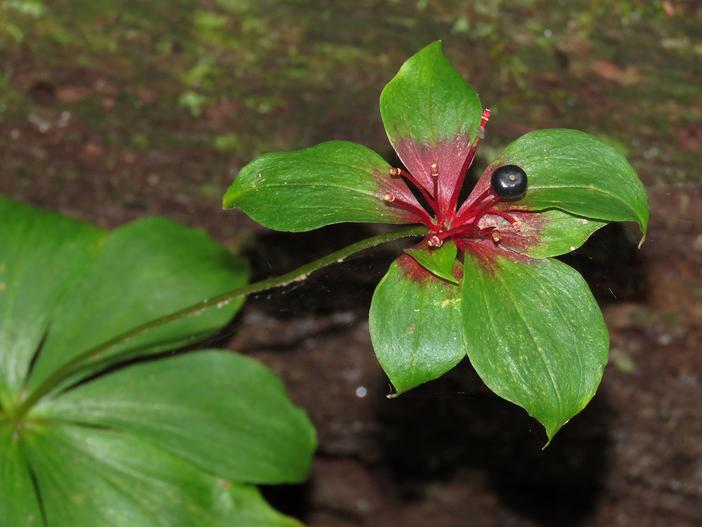Indian Cucumber
(Medeola virginiana)
Indian Cucumber (Medeola virginiana)
/
/

Katja Schulz
CC BY 2.0
Image By:
Katja Schulz
Recorded By:
Copyright:
CC BY 2.0
Copyright Notice:
Photo by: Katja Schulz | License Type: CC BY 2.0 | License URL: https://creativecommons.org/licenses/by/2.0/ | Uploader: treegrow | Publisher: Flickr












































































Estimated Native Range
Summary
Medeola virginiana, commonly known as Indian Cucumber, is a deciduous perennial herb native to the rich, moist deciduous forests of the Eastern United States. It typically grows to a height of 30 inches (76 cm). The plant features a whorl of leaves at the base and a second tier of leaves supporting the flower stalk. The flowers, which bloom in late spring, are small with yellowish-green tepals and are not particularly showy. Following flowering, the plant produces dark blue to purple berries, which are inedible and positioned above the top tier of leaves. The underground part of the plant consists of a tuber-like structure that gives rise to shoots each spring. This structure also produces horizontal rhizomes, which facilitate the spread of the plant, forming clonal colonies in an octagonal pattern.
Indian Cucumber is valued for its crisp, edible tuber that has a fragrance and flavor reminiscent of garden cucumber. The tuber can be consumed raw or cooked after washing. This plant is an excellent choice for naturalistic plantings in shaded woodland gardens, as it can provide a unique culinary element. It thrives in part shade to full shade and prefers medium to high moisture levels in soils with good drainage. While it is not commonly afflicted by diseases, it can be sensitive to overly dry conditions and may require additional watering during prolonged dry spells. Gardeners should note that while the tuber is edible, the berries are not and should not be consumed.CC BY-SA 4.0
Indian Cucumber is valued for its crisp, edible tuber that has a fragrance and flavor reminiscent of garden cucumber. The tuber can be consumed raw or cooked after washing. This plant is an excellent choice for naturalistic plantings in shaded woodland gardens, as it can provide a unique culinary element. It thrives in part shade to full shade and prefers medium to high moisture levels in soils with good drainage. While it is not commonly afflicted by diseases, it can be sensitive to overly dry conditions and may require additional watering during prolonged dry spells. Gardeners should note that while the tuber is edible, the berries are not and should not be consumed.CC BY-SA 4.0
Plant Description
- Plant Type: Herb
- Height: 1-2 feet
- Width: 1-1.5 feet
- Growth Rate: Moderate
- Flower Color: N/A
- Flowering Season: Spring, Summer
- Leaf Retention: Deciduous
Growth Requirements
- Sun: Part Shade, Full Shade
- Water: Medium, High
- Drainage: Fast, Medium
Common Uses
Bird Garden, Edible*Disclaimer: Easyscape's listed plant edibility is for informational use. Always verify the safety and proper identification of any plant before consumption., Low Maintenance, Water Garden
Natural Habitat
Rich, moist deciduous forests of the Eastern United States
Other Names
Common Names: Indian Cucumber-Root , Concombre Sauvage , Jarnotte , Médéole , Médéole De Virginie
Scientific Names: Medeola virginiana , Medeola virginica , Gyromia acuminata , Gyromia cuneata , Gyromia virginica , Gyromia virginica var. picta , Medeola verticillifolia
GBIF Accepted Name: Medeola virginiana L.